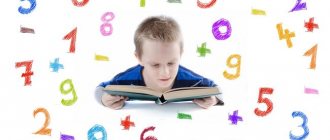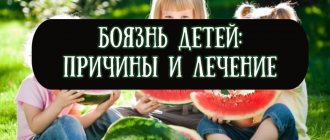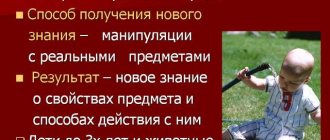Perception
Perception has a number of features:
- Perception is emotionally charged and closely related to practical actions: observed objects “attract” the child, causing an emotional reaction and a desire to get them and do something with them. The child learns the properties of objects (shape, size, texture, color, etc.) in the process of practical actions: grasping, manipulation, relationships, and other actions.
- The child cannot simultaneously perceive the object as a whole and its individual parts. Therefore, he may “lose” his mother in the store, unable to single out her face from a large number of faces: he either carefully studies one face, or begins to randomly wander his eyes over the entire mass of faces, not noticing the details.
- Over time, the child begins to visually compare the properties of objects, whereas previously he compared them “with the help of his hands.” Now he selects the desired object and performs the action immediately correctly, without first trying it on.
- Sensory standards begin to emerge—ideas about the properties of things: the child can quite accurately determine the shape, size, and color of objects, although it is still difficult for him to master the names of these properties. For example, a child can define round objects as “like a ball,” and green objects as “like grass.” In the third year of life, a child acquires the idea of 5–6 shapes (circle, oval, square, rectangle, triangle, polygon) and 8 primary colors, but children master their names with great difficulty and only with persistent teaching from adults. The main difficulty for children of this age is the inability to separate a property from the object itself. To develop a child’s ideas about the properties of objects, specific practical actions with objects and interaction with adults are necessary.
Cognitive development of preschoolers card index
Development of cognitive processes in a preschooler.
What is this “cognitive development” and why is it so important to play with children?! Cognitive development, that is, the formation and development of a person’s cognitive sphere, namely his perception, memory, thinking, speech, imagination, attention.
When asking these questions, it is important not to miss the most important thing: the child’s psyche develops in play, each mental process is inseparable from the general development of the child. Let's take a closer look.
Thinking is a mental process of reflecting reality, the highest form of human creative activity. This is a creative transformation of their subjective images in the human mind, their meaning and meaning to resolve real contradictions in the circumstances of people’s life, to form new goals, discover new means and plans for achieving them, revealing the essence of the objective forces of nature and society.
Thinking as the purposeful use, development and increase of knowledge is possible only if it is aimed at resolving contradictions that are objectively inherent in the real subject of thought. In the genesis of thinking, the most important role is played by people’s understanding of each other, the means and objects of their joint activities.
It is thinking that plays a special role, and it is consistently formed as follows:
- visually effective;
- visually figurative;
-verbal-logical.
As a result, we are able to analyze, synthesize information, generalize, compare, specify and abstract.
Games for developing thinking:
We offer you several games to develop this important component of the psyche.
Game 1: “Edible-Inedible” - this game is familiar to many of us since childhood. The rules are simple, and the benefits are difficult to overestimate. An adult offers the child any object, and the child must classify it as edible or inedible (can be combined with throwing a ball, thereby overcoming physical inactivity);
Game 2: “Housewarming party at the nesting dolls” (develops systematization skills).
The nesting dolls settled in a new house, each got their own apartment: the smallest on the first floor, a little larger on the second, even larger on the third, even larger on the fourth, and the largest on the fifth. They were happy and went for a walk in the park. In the evening they came and forgot who lived where. Help the nesting doll find their apartments, tell us who lives where?
Game 3: “Match a word.”
The adult throws the ball to the child and names the category (for example, toy). The child’s task is to choose a pair for this category (for example, a toy - a car). Then the players change roles.
Game 4: “The 4th extra.”
This game can also be played without using any special aids. An adult names four objects, one of which is redundant. The child needs to identify the extra item and explain his choice. Children's logic can be incredible!
Game 5: “Create a riddle”
The driver comes up with a riddle about some object, describing the mystery in words. The rest of the participants need to guess.
There are a great many thinking games and they are limited only by your imagination.
Memory is the remembering, preservation and subsequent reproduction by an individual of his experience. The physiological basis of memory is the formation, preservation and updating of temporary connections in the brain. Temporary connections and their systems are formed when the action of stimuli on the sense organs is adjacent in time and when the individual has orientation, attention, and interest in these stimuli.
In older preschool age (5 and 6 years old), a transition occurs from involuntary memory to the initial stages of voluntary memorization and recall. At the same time, there is a differentiation of a special kind of actions that correspond to the goals: remember, recall, which are set for children. The child’s active identification and awareness of mnemonic goals (that is, memorization goals) occurs in the presence of appropriate motives; the memorization process is formed by the end of preschool age, i.e., at the age of 6–7 years. It is characterized by attempts to form mental logical connections between memorized words. The existence of such connections is, first of all, indicated by the very nature of reproduction. During reproduction, the child changes the order of the objects named to him and combines them according to their purpose. Initially, the methods of memorization, as well as the methods of recall, are very primitive and not yet specialized enough. The child takes them from those actions that he already owns. These are methods such as, for example, repeating an order after an adult or returning a child in the process of remembering to the links he has already reproduced.
Memory development games:
Train your memory!
Game 1: “Snowball” - development of auditory mechanical memory. Any number of household members can participate. The first one names a word, the next one repeats it and names his own, etc. To make the task easier, you can take a separate topic and/or name each next word starting with the last letter of the previous one.
Game 2: “Smells and Sounds” - developing tactile memory.
Imagine it is raining. You stand at the window and look out onto the street. What do you see? Tell me. Imagine raindrops hitting glass. Remember how the rain makes noise. The rain has stopped, you went outside. Remember the smell of earth and grass after rain. What do you think the smell of grass after rain can be compared to?
Game 3: “Riddles” - development of auditory memory.
The adult makes a riddle, and the child draws the answer (for example):
What kind of forest animal
Stood up like a post under a pine tree
And stands among the grass
Are your ears bigger than your head?
The adult asks the child to repeat the riddle.
Game 4: “Screen” - development of visual memory.
Objects are laid out in front of the child (no more than 7; the younger the child, the fewer objects need to be used). The child is asked to remember what is where. Next, the baby turns away or closes his eyes, the adult makes changes, and the child tries to return everything to the way it was.
Game 5: “Pairs of pictures” - development of semantic memory.
Prepare 7-8 pictures related to each other in meaning. Arrange them in pairs: (for example) a picture of a tree is placed next to a picture of a forest. The child is asked to carefully look at all the pictures and remember. After 1-2 minutes, remove the pictures from the first row. Ask your child, looking at the pictures from the second row, to remember those that were removed.
Attention is the process and state of tuning a subject to perceive priority information and perform assigned tasks. Theoretically and operationally, attention is characterized by level (intensity, concentration), volume, selectivity, speed of switching (movement), duration and stability.
At this age, preschoolers' attention also improves. In the youngest preschooler, involuntary attention, caused by externally attracted objects, events and people, predominates, and in the older preschooler, the ability to voluntarily concentrate attention is manifested, especially if it is regulated by speech.
S.L. Rubenstein notes that after the age of 3, a child’s level of attention stability increases sharply and shows a relatively high level by the age of 6, which is one of the indicators of a child’s readiness for school. The distractibility of a 2-4 year old child is 2-3 times greater than the distractibility of a 4-6 year old.
Games to develop attention:
Game 1: “What do you hear?” — development of voluntary attention, stability.
Option 1: the presenter invites the children to listen and remember what is happening outside the door. He then asks to tell what they heard.
Option 2: at the leader’s signal, the children’s attention is drawn from the door to the window, from the window to the door. Then each child must tell what happened behind them.
Game 2: “Find the same one” - goal: development of voluntary attention
Invite your child to choose from cubes or balls exactly the same (in color, size, design) as the one you have in your hands. To make it more interesting for your child to play, you can wish for objects with him in turn and, of course, make mistakes that the child should notice. You can make the game more difficult by increasing the number of items whose differences are not so noticeable.
Game 3: “What has changed?” - development of attention, reaction speed.
To begin, place 3-4 toys on the table and let the child look at them for 1-2 minutes. Then ask him to turn away and remove one of the toys. When the baby turns around, ask him what has changed. The game can be complicated by increasing the number of toys to 5-7. You can turn this game into a competition by asking each other problems in turns.
Game 4: “Attention Gymnastics” - development of voluntary attention
"One, two, three, four, five
we start playing
you guys don't yawn
listen to what I tell you
and at the same time I will show you"
Naming parts of your body, show them on yourself (puts your hand on them). Children repeat the movements. Then they begin to confuse the children, naming one part of the body and showing another.
Game 5: “Damaged Phone” - development of attention and auditory perception.
Option 1.
Children sit in a row or in a circle. The presenter quietly, in his ear, calls out a word or phrase to his neighbor, who passes it on
. The last of the children names what they heard, after which the new leader gives the word.
Option 2.
Some of the children leave the office. The presenter reads a short story to the remaining children. The first of the players behind the door enters the office, and one of those present tells him what he heard. Then the second child comes in, and the previous one tells him everything he remembers from the story. The whole game continues like this.
Imagination is a universal human ability to construct new holistic images of reality by processing the content of existing practical, sensory, intellectual and emotional-semantic experience. Imagination is a way for a person to master the sphere of a possible future, giving his activity a goal-setting and design character, thanks to which he stood out from the “kingdom” of animals. Being the psychological basis of creativity, imagination ensures both the historical creation of cultural forms and their development in ontogenesis.
Imagination is the figurative construction of the content of the concept of an object even before this concept itself is formed. The content of a future thought is fixed by the imagination in the form of some significant, general tendency in the development of an integral object. A person can comprehend this tendency as a genetic pattern only through thinking.
Games to develop imagination:
Game 1: “Getting to know the apartment by touch”: the player is blindfolded and, together with the host, goes on a journey through the apartment. Everything and everyone encountered along the way is felt, sniffed and a conclusion is drawn as to what it is. This game develops all senses, as well as coordination, plasticity, and corrects lack of coordination and hyperactivity.
Game 2: “What does it look like?”
Remember the Rorschach test, the one with the blots? This game is based on it (or a Rorschach test based on this game...). Drop thinly diluted gouache onto a thick sheet of white paper and fold it in half. Then unfold it and start inventing objects or creatures with the children that are associated with the blot. It is important to come up with different types of associations. The sooner a child trains to see a wide variety of things in blots, the healthier his psyche. This exercise trains the flexibility of thinking, its ability to switch.
Game 3: "Metamorphoses"
What it is? Metamorphoses are transformations, changes. In this game we transform objects (usually faulty ones) into something completely new, giving them a second life. For example, an old electric kettle can be turned into a watering can for flowers or an office stand...
Game 4: “What’s above us is upside down.” Imagine that all the things around have eyes, what can these things see? What does the picture on the wall “see”? What are the cups “whispering” about in the sideboard? This game develops the ability to put oneself in a different spatial point of view and develops imagination. It also helps to correct children's egocentrism.
Game 5: Offer your child questions starting with the words “What will happen if...”. The child’s task is to give as complete and original answers to the questions as possible.
List of sample questions:
“What happens if it rains nonstop?”
“What would happen if all animals started speaking with human voices?”
“What would happen if all the mountains suddenly turned into sugar mountains?”
“What happens if you grow wings?”
“What will happen if all the fairy-tale heroes come to life?”
The more detailed and detailed the child answers, the more clearly his imagery and
"creativity - creativity" of the imagination.
Perception is:
1. A subjective image of an object, phenomenon or process that directly affects the analyzer or system of analyzers.
2. The complex psychophysiological process of perceptual image formation. Sometimes the term perception denotes a system of actions aimed at becoming familiar with an object that affects the senses, i.e., sensory-research activity of observation.
Over the course of a person’s life, perception goes through a complex path of development. The development of perception occurs especially intensively in the first years of a child’s life. Changes in perception in preschool children occur in connection with the development of various types of children’s activities (play, visual, constructive, and elements of labor and education).
Games for the development of perception:
Game 1: “Run to me!” — to train children in the ability to compare colors, to help consolidate knowledge and the color system. We will need blue, red, yellow, green flags. The players take one at a time, the leader takes four flags (of all colors).
-Place the flags on your knees. Raise the blue (red, yellow, green) flags. (Players holding flags of the named color raise them.)
-Now I will name flags of one color or another. First look at my flag, then at your flag, and if their colors match, then run to me.
The presenter moves away some distance, raises one flag (holds the rest behind his back) and names its color, then gives the command: “Red flags, run towards me!” Players run up to him, raise flags, checking whether they completed the task correctly, wave them and sit down, etc.
Game 2: “Coloring of water” - forming an idea of different shades of color based on lightness. Vocabulary: light, dark, lighter, darker.
Option 1: “Today we will color the water, we will get red water of different shades. The water in jars is colorless, but we will make it colored. Watch how I will paint with water: I take the paint on the brush, dip the brush halfway, and now rinse it in one jar. I got light red water. And in another jar I will put more paint: I will dip the brush completely in the paint, rinse it, pick up the paint again and rinse it again in the same jar. The result was also red water, but darker.
Option 2: This is done in the same way as in Option 1, only now six colors of paint are distributed.
Game 3: Game “Recognize by sound” - the child sits with his back to the adult, who makes noises and sounds with various objects. The child must guess what produced the sound.
Game 4: Game “What’s inside” - the child is offered balloons containing various fillings inside: water, sand, peas, beans, semolina, rice, flour, buckwheat, etc.). The balls must be in pairs. The child must find pairs with the same fillings by touch.
Game 5: “Taste it” - a blindfolded child tastes pickled cucumber, sweet candy, sour lemon, bitter onion, and expresses his feelings in words.
Options:
- the child tastes raw and cooked foods;
- a child with his eyes closed identifies different types of bread;
- the child determines what kind of fruit he tried;
- the child determines the type of nuts by taste
- the child determines the type of jam and sweets
The preschool period is an important stage in the cognitive development of children, during which the formation of all higher mental functions occurs - perception, thinking, memory, speech, intelligence, etc. It is important not only that children develop harmoniously, but also be happy while experiencing the magical stage of childhood.
Memory
Memory processes improve throughout early childhood. These include: storage, recognition and reproduction. By 14 months of age, the duration of information retention increases to a whole week. A child at this age can remember not only individual actions, but also the simplest chains of actions. By 20 months of age, a child can reproduce a sequence of actions not only immediately after presentation, but also with a 2-week delay. Later in development, the ability to reproduce significantly improves. In general, a child’s memory is still involuntary—the child does not specifically set a task to remember.
When is the best time to develop cognitive abilities?
Previously, it was believed that cognitive abilities develop in a person until the age of 20–25, and after 40 they begin to slowly fade away; there is even a phrase “Nerve cells do not recover.” However, recent studies have proven that this is not so, nerve cells are replaced with new ones, like everything else in the body, and the development of cognitive abilities is possible at any age. The brain, which systematically performs certain mental work, develops its potential. Remember how children learn to read, how hard mental work tires them at first, but very soon, without thinking, they put syllables into words, and words into sentences.
Cognitive functions are divided into:
- memory;
- attention;
- speech;
- praxis (purposeful activity);
- gnosis (orientation, recognition of place and time);
- thinking.
All of them can be developed at any age, but it is better to start from the earliest, preschool years.
Thinking
The child’s thinking during this period is limited to a visual situation ( situational thinking ) and develops against the background of practical activity. He solves all the problems facing him with the help of practical actions that are clear to him in the present tense. The child acts with objects and thus grasps the connections between them. Up to two years there is a process of active experimentation by trial and error. The child explores objects by influencing them in new ways.
Persistent reproduction of the same simple actions and obtaining the expected effect (opening and closing boxes, drawers, making sounds from sounding toys, the actions of one object on another, etc.) give the baby an extremely important sensory experience, which forms the basis for more complex, internal forms of thinking. The child learns the essential and functional characteristics of objects. Such knowledge captivates the baby and brings him new emotions - cognitive ones: curiosity, surprise, joy of discovery. Cognitive activity and the development of thinking are manifested not only in the success of solving practical problems, but above all in the pleasure that the child receives from independent research. The child endlessly enjoys exploring new things.
An important characteristic of thinking is the ability to transfer the found method of solving a problem to new objects and conditions. The study of objects and knowledge of the world leads to the fact that in the second year of life the child distributes objects into categories, but not according to the similarity of appearance, but according to the similarity of their functions and behavior. Now the child understands that certain actions are suitable for some categories of objects, but not for others. For example, you can feed imaginary porridge from a spoon to a teddy bear, but you cannot feed a toy car.
At 18–24 months, symbolic thinking —the ability to solve practical problems without openly experimenting with actions, the ability to transfer, and transfer actions to the internal plane. For example, a child can pretend to drink from a cup using a cube instead, or imagine that a mother doll is feeding a daughter doll. The sign function of consciousness begins to form. The child may act “as if,” replacing real objects with similar or imaginary symbols (for example, acting with a stick as a spoon or a cube as a cup). Thus, there is a gradual development of solving problems in the mind - the beginnings of “thinking within oneself.”
Phenomena of thinking
Among the phenomena in a child’s thinking, we can distinguish the following: animism: a child may believe that all moving objects are alive: the sun, the moon, clouds, a car.
Another feature of thinking is materialization: objects and people from the fantasy world become absolutely real for them. So, if a child falls, he can blame the road he was walking on for his fall. Or believe that the vase fell because she wanted it to. A two-year-old child has little understanding of what is real and what is not.
The emergence of animism and materialization is partly explained by another characteristic of the thinking of children of this age: egocentrism. This term refers to the tendency of children to see and understand things exclusively from their own point of view, i.e. the child cannot take the point of view of another person or look at the situation abstractly, or separate from it. In addition, at two years old, the child sincerely believes that his parents know what he is thinking about (that they can read his thoughts). And that other people feel and think the same things as he does.
Bottom line
In cognitive terms, during this period the following is formed:
- The initial concept of the world - what it consists of, what happens in it, according to what laws;
- The ability to establish connections and relationships between objects;
- The ability to generalize and transfer acquired experience to other objects and situations;
- Ability to solve specific problems by experimenting with objects;
- The ability to solve basic problems “within oneself.”
- Voluntary attention;
- The memory capacity and duration of memorization increases;
Read more about how to develop a child’s thinking and curiosity at 1-3 years old.
Personality development factors
All factors that in one way or another influence the emotional and intellectual development of a child can be divided into 2 large groups: organic and sociocultural. Organic factors include genetic inclinations that a child inherits from his parents. Of course, this heredity is not unconditional and largely depends on how the pregnancy proceeded. Continuous stress, bad habits of the mother, lack of oxygen and nutrients and other potentially dangerous circumstances of the child’s intrauterine development can subsequently lead to various pathologies in his mental and personal development.
A good socioeconomic status means that parents have enough time and money at their disposal to provide their child with everything necessary for his successful mental development - first of all, their attention.
But no less important in the formation of a healthy emotional and intellectual constitution of a child is his social environment, which is primarily characterized by such a concept as socioeconomic status. Despite the definition of “economic” in the name of this factor, it has a very indirect relationship to the material well-being of the family, although it is partly determined by it. A good socioeconomic status means that parents have enough time and money at their disposal to provide their child with everything necessary for his successful mental development - first of all, their attention. If parents are constantly busy with their own affairs - regardless of whether they make ends meet, working three jobs, or are focused on their own career in a large and successful company - and pay critically little attention to communication with their child, this will inevitably affect on its development in a negative way. That is, socioeconomic status as a factor of cognitive development means the ability of parents to provide their child with due attention, to be sensitive to not only his material, but also emotional needs.









